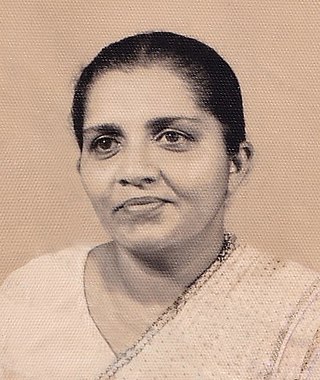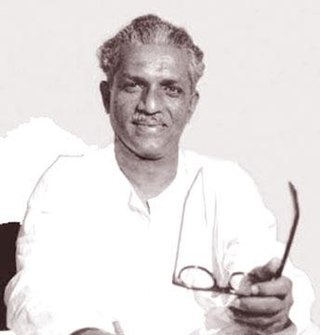
Nanayakkarapathirage Martin Perera, commonly known as Dr. N. M. Perera, was one of the leaders of the Sri Lankan Trotskyist Lanka Sama Samaja Party (LSSP). He was the first Trotskyist to become a cabinet minister. He served two terms as Minister of Finance and Leader of the Opposition, as well as one term as the Mayor of Colombo.
Bolshevik–Leninist Party of India, Ceylon and Burma (BLPI) was a revolutionary Trotskyist party which campaigned for independence and socialism in South Asia. The party was formed in 1942 as a unification of two Indian groups, with the Lanka Sama Samaja Party of Ceylon. It was recognised as the Indian section of the Fourth International.

The Lanka Sama Samaja Party, often abbreviated as LSSP, is a major Trotskyist political party in Sri Lanka. It was the first political party in Sri Lanka, having been founded in 1935 by Leslie Goonewardene, N.M. Perera, Colvin R. de Silva, Philip Gunawardena and Robert Gunawardena. It currently is a member of the main ruling coalition in the government of Sri Lanka and is headed by Tissa Vitharana. The party was founded with leninist ideals, and is classified as a party with socialist aims.
The Hartal 1953 was a country-wide demonstration of civil disobedience and strike, commonly known as a hartal, held in Ceylon on 12 August 1953. It was organized to protest against the policies and actions of the incumbent United National Party government. It was the first mass political action in Ceylon and the first major social crisis after independence. This event is of historical significance because it was the first people's struggle against an elected government in the country.
The Government Clerical Service Union (GCSU) is a trade union of clerical workers who work in the public sector in Sri Lanka. This was formed in the 1920s when Sri Lanka (Ceylon) was under British colonial rule. It is a politically independent trade union but the majority of the activists were Communists early in its history.

Anil Moonesinghe was a Sri Lankan Trotskyist revolutionary politician and trade unionist. He became a member of parliament, a Cabinet Minister of Transport in 1964, the Deputy Speaker of Parliament from 1994 to 2000 and a diplomat. He has authored several books and edited newspapers and magazines. He was chairman and general manager of a State corporation. He briefly held the honorary rank of colonel.

Colvin Reginald de Silva was a Cabinet Minister of Plantation Industries and Constitutional Affairs, prominent member of parliament, Trotskyist leader and lawyer in Sri Lanka. He was one of the founders of the Lanka Sama Samaja Party – the first Marxist party in Sri Lanka.

Violet Vivienne Goonewardene, commonly known as "Vivi", was a Sri Lankan anti-colonial activist and prominent politician, serving as one of the world's first female ministers. A key figure in both the Indian independence movement and the Sri Lankan independence movement, Goonewardene was a prominent member on the non-aligned stage, where she fought against perceived injustices and was critical of the Middle East diplomacy sponsored by the United States. Goonewardene was the first and, to date, only female National Hero of Sri Lanka. By her death, she was one of the Left's most vibrant personalities, and the foremost female figure in the Sri Lankan leftist movement.
During the Donoughmore period of political experimentation (1931–48), several Sri Lanka leftist parties were formed in British colonial Ceylon. Unlike most other Sri Lankan parties, these leftist parties were noncommunal in membership.

The Sri Lankan independence movement was a peaceful political movement which was aimed at achieving independence and self-rule for the country of Sri Lanka, then British Ceylon, from the British Empire. The switch of powers was generally known as peaceful transfer of power from the British administration to Ceylon representatives, a phrase that implies considerable continuity with a colonial era that lasted 400 years. It was initiated around the turn of the 20th century and led mostly by the educated middle class. It succeeded when, on 4 February 1948, Ceylon was granted independence as the Dominion of Ceylon. Dominion status within the British Commonwealth was retained for the next 24 years until 22 May 1972 when it became a republic and was renamed the Republic of Sri Lanka.

Edmund Peter Samarakkody was a Ceylonese lawyer, trade unionist, politician and Member of Parliament.
The Ceylon Federation of Labour (CFL) is an organisation bringing together trade unions in the private, semi-government and co-operative sectors of Sri Lanka.

Don Philip Rupasinghe Gunawardena was a Sri Lankan Marxist politician and leftist. A founder of the Lanka Sama Samaja Party, the first political party in Ceylon which was known for having introduced Trotskyism, he later formed the Mahajana Eksath Peramuna and was called 'the Father of Socialism' and as 'the Lion of Boralugoda'. A member of the State Council of Ceylon and the Parliament of Ceylon, he served as the Minister of Agriculture and food under S. W. R. D. Bandaranaike from 1956 to 1959 and as Minister of Industries and Fisheries in the national government under Dudley Senanayake from 1965 to 1970.
The history of Sri Lanka Transport Board, the state-run, primary bus operator in Sri Lanka, goes back to 1 January 1958. The state-owned enterprise was at the time known as the Ceylon Transport Board. At its peak, it was the largest omnibus company in the world - with about 7,000 buses and over 50,000 employees. With privatization in 1979, it underwent a period of decline. First broken up into several regional boards, then into several companies, it was finally reconstituted as the Sri Lanka Transport Board in 2005.

Leslie Simon Goonewardene was a prominent Sri Lankan statesman. He founded Sri Lanka's first political party, the Lanka Sama Samaja Party, in 1935, and served as its General-Secretary from 1935 to 1977. Goonewardene was a key figure in both the Indian independence movement and the Sri Lankan independence movement. He was designated as a National Hero of Sri Lanka for his leadership in the independence movement, and his efforts are celebrated each year on the Sri Lankan Independence Day.
Vaithianathan Karalasingham was a Ceylon Tamil lawyer, writer, politician and one of the leading members of the Lanka Sama Samaja Party.
Weerahennedige Theodore Wilfred Meryl Fernando was a Ceylonese teacher, trade unionist, politician and Member of Parliament.

Sebastian Cyril Constantine Anthony Pillai, also spelled S.C.C. Anthonypillai, was a Ceylonese-Indian trade unionist, politician and Member of Parliament.
Merengna Gaulius Mendis was a Sri Lankan trade unionist and a member of the Parliament of Sri Lanka.
Communism in Sri Lanka dates back to 1935, when the Lanka Sama Samaja Party was founded by Trotskyists who campaigned for freedom and independence of Sri Lanka which was then a colony of the British Empire and known as Ceylon.









